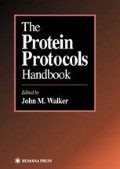Abstract
Although most prokaryotic proteins have free NH2-termini and therefore can be directly sequenced, most eukaryotic proteins have blocked NH2-termini which precludes Edman degradation (1,2). In these instances, one of the most direct approaches to obtaining partial amino acid sequences is via enzymatic or chemical cleavage followed by peptide fractionation and sequencing. Although several different approaches may be taken to cleave proteins, one of the most common is to digest the protein enzymatically with a relatively specific protease such as trypsin or lysyl endopeptidase. Since final purification is often dependent on SDS-PAGE, cleavage procedures that can either be carried out in the polyacrylamide gel matrix (3,4) or that may be used on samples that have been blotted from SDS polyacrylamide gels onto PVDF (5) or nitrocellulose (5,6) membranes are extremely useful. In both instances, the proteins are usually stained with Coomassie blue or Ponceau S prior to excision, and proteolytic digestion and the resulting peptides are separated by reverse-phase HPLC. Relatively straightforward solution and in-gel digestion procedures that have been used extensively in the Keck Foundation Biotechnology Resource Laboratory at Yale University will be described in this chapter, whereas a procedure suitable for in situ digestion of SDS-PAGE blotted proteins is described in Chapter 70.
Access this chapter
Tax calculation will be finalised at checkout
Purchases are for personal use only
References
Brown, J. L. and Roberts, W. K. (1976) Evidence that approximately eighty percent of the soluble proteins from Ehrlich Ascites cells are amino terminally acetylated. J. Biol. Chem. 251, 1009–1014.
Driessen, H. P., DeJong, W. W., Tesser, G. I., and Bloemendal, H. (1985) The mechanism of N-terminal acetylation of proteins in Critical Reviews in Biochemistry vol. 18 (Fasman, G. D., ed.), CRC, Boca Raton, FL, pp. 281–325.
Williams. K. R. and Stone, K. L. (1995) In gel digestion of SDS PAGE-separated protein: observations from internal sequencing of 25 proteins in Techniques in Protein Chemistry VI (Crabb, J. W., ed.), Academic, San Diego, pp. 143–152.
Rosenfeld, J., Capdevielle, J., Guillemot, J., and Ferrara, P. (1992) In gel digestions of proteins for internal sequence analysis after 1 or 2 dimensional gel electrophoresis. Anal. Biochem. 203, 173–179.
Fernandez, J., DeMott, M., Atherton, D., and Mische, S. M. (1992) Internal protein sequence analysis: enzymatic digestion for less than 10 µg of protein bound to polyvinylidene difluoride or nitrocellulose membranes. Anal. Biochem. 201, 255–264.
Aebersold, R. H., Leavitt, J., Saavedra, R. A., Hood, L. E., and Kent, S. B. (1987) Internal amino acid sequence analysis of proteins separated by one-or two-dimensional gel electrophoresis after in situ protease digestion on nitrocellulose. Proc. Natl. Acad. Sci. USA 84, 6970–6974.
Stone, K. L., LoPresti, M. B., and Williams, K. R. (1990) Enzymatic digestion of proteins and HPLC peptide isolation in the subnanomole range in Laboratory Methodology in Biochemistry: Amino Acid Analysis and Protein Sequencing (Fini, C., Floridi, A., Finelli, V., and Wittman-Liebold, B., eds.), CRC, Boca Raton, FL, pp. 181–205.
Sun, Y., Zhou, Z., and Smith, D. (1989) Location of disulfide bonds in proteins by partial acid hydrolysis and mass spectrometry in Techniques in Protein Chemistry (Hugli, T., ed.), Academic, San Diego, pp. 176–185.
Lombard-Platet, G. and Jalinot, P. (1993) Funnel-well SDS-PAGE: a rapid technique for obtaining sufficient quantities of low-abundance proteins for internal sequence analysis. BioTechniques 15, 669–672.
Author information
Authors and Affiliations
Editor information
Editors and Affiliations
Rights and permissions
Copyright information
© 1996 Humana Press Inc., Totowa, NJ
About this protocol
Cite this protocol
Stone, K.L., Williams, K.R. (1996). Enzymatic Digestion of Proteins in Solution and in SDS Polyacrylamide Gels. In: Walker, J.M. (eds) The Protein Protocols Handbook. Springer Protocols Handbooks. Humana Press. https://doi.org/10.1007/978-1-60327-259-9_71
Download citation
DOI: https://doi.org/10.1007/978-1-60327-259-9_71
Publisher Name: Humana Press
Print ISBN: 978-0-89603-338-2
Online ISBN: 978-1-60327-259-9
eBook Packages: Springer Book Archive

